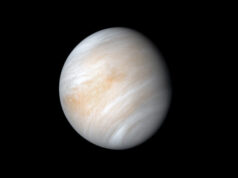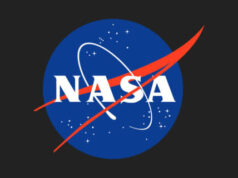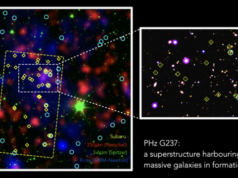You can tell Earth and the moon’s shadows apart by their edges: Earth’s is fuzzy, while the moon’s is sharp and distinct. This is because Earth’s atmosphere absorbs some of the sun’s light, creating an ill-defined edge. On the other hand, the moon has no atmosphere, producing a crisp horizon. Credits: NASA/SDO
Early in the morning of Sept. 1, 2016, NASA’s Solar Dynamics Observatory, or SDO, caught both Earth and the moon crossing in front of the sun. SDO keeps a constant eye on the sun, but during SDO’s semiannual eclipse seasons, Earth briefly blocks SDO’s line of sight each day – a consequence of SDO’s geosynchronous orbit. On Sept. 1, Earth completely eclipsed the sun from SDO’s perspective just as the moon began its journey across the face of the sun. The end of the Earth eclipse happened just in time for SDO to catch the final stages of the lunar transit.
In the SDO data, you can tell Earth and the moon’s shadows apart by their edges: Earth’s is fuzzy, while the moon’s is sharp and distinct. This is because Earth’s atmosphere absorbs some of the sun’s light, creating an ill-defined edge. On the other hand, the moon has no atmosphere, producing a crisp horizon.
This particular geometry of Earth, the moon and the sun had effects on viewing down on the ground as well: It resulted in a simultaneous eclipse visible from southern Africa. The eclipse was what’s known as a ring of fire, or annular, eclipse, which is similar to a total solar eclipse, except it happens when the moon is at a point in its orbit farther from Earth than average. The increased distance causes the moon’s apparent size to be smaller, so it doesn’t block the entire face of the sun. This leaves a bright, narrow ring of the solar surface visible, looking much like a ring of fire.
Source:Nasa











